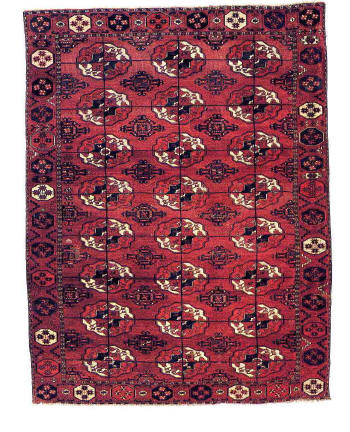| |
 |
|
| |
42
Tekke Main Carpet, circa 1800
In addition to bags, camel trappings, and other
small utilitarian objects in knotted pile, Turkmen
tribeswomen made main carpets for their
tent floors. On their red fields, Tekke carpets
have large, quartered main guls that alternate
with smaller, often cruciform, guls enclosed in blue gridwork.
Because they were produced throughout the
19th century and exported in quantity,
these rugs have spawned a host of
mechanical-looking modern imitations, including Pakistani versions
in Western-living-room colors never
imagined by Tekke weavers.
The earliest surviving Tekke carpets, however, transcend this modern
stereotype. The wool of this example is
soft and glossy, and its guls are spaciously distributed over a
glowing red field. At the left side of the
field, the weaver has added a few tiny flowers and comb-like
amulets for variety. As in other early Tekke carpets, the borders
are simple: uncluttered octagons alternating with stepped v's
and a few other randomly inserted motifs
that counter the regularity of the field pattern. The carpet has
lost a vertical row of major
guls at the right and at least one horizontal row at the
bottom, and what remains of it has patches
made from these missing parts. Despite its fragmentary condition, it
retains the qualities of spontaneity, rich
color, and tactile appeal sorely missing from its numerous progeny.
J.B. |
|
| |
|
|
|
|
| |
| SIZE: 82 x
63 in. (208.3 x 160 cm.) |
| WARP: wool, Z2S;
ivory |
| WEFT: wool, Z2S x
2; light brown |
| PILE: wool, Z2S,
asymmetrical knots open right, h.
10, v. 15, 150 k/sq. in.; ivory, brown, dark brown,
brown-red, orange-red, blue-green, blue |
| ENDS: cut |
| SIDES: cut, modern
cord attached |
|
|
| |
|
|
|
|
THROUGH THE COLLECTOR'S EYE |
 |
|
Oriental Rugs from New England Private Collections |
| |
|
|
|